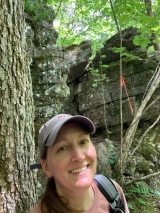Radford University
Karen Powers
Professor
Biology, Dept of
- Phone:
- (540) 831-5146
- Address:
-
Center for the Sciences 178
PO Box 6931 - Email:
- kpowers4@radford.edu


Courses Taught
- BIOL 103 - Environmental Biology
- BIOL 105 - Biology for the Health Sciences
- BIOL 160 - Freshman Biology Seminar
- BIOL 216 - General Zoology
- BIOL 232 - Organismal Biology
- BIOL 390 - Conservation Biology
- BIOL 460 - Senior Biology Seminar - Wildlife Management in Virginia
- BIOL 464 - Vertebrate Zoology
- BIOL 481 - Fire Ecology
- BIOL 481 - Museum Techniques
- BIOL 481 - Research in Bird-Window Collisions
- BIOL 488/491/495 - Independent Research
About
My teaching interests focus on community ecology and wildlife management. I teach many of the -ology classes with focus on taxonomy, natural history, and use/development of our natural history collection. I also developed a course in Fire Ecology, which includes a prescribed burn of a restored native grassland at Radford University's Selu Conservancy.
I am the faculty advisor for the Radford University Student Chapter of The Wildlife Society (follow us on Facebook!) and for students with an interest in veterinary medicine. I also curate the natural history collection in the Biology Department.
My research interests are broad, encompassing many aspects of vertebrate ecology and habitat management. Recent projects and publications have focused on the effects of White-nose Syndrome on bat communities in the eastern United States and the status of Allegheny woodrats in Virginia. We have taken a turn to examining ectoparasites (bot flies and fleas) in woodrats in recent years. This summer work with bats and woodrats welcomes a small crew of 3-5, completing research across western Virginia.
On campus, we have been documenting bird-window collisions since 2018, and recently published our 8th article with student authors. The bird-window collision research continues to welcome 8-10 students a semester, each student collaboratively collecting data and developing independent research questions based on our growing dataset.
Publications from 2019 to present are listed below, many with student co-authors (indicated by *).
- Powers, K.E., W.W. Sadler*, A.J. Carter-Martin*, G.C. Smith*, G.W. Tieskotter*, K.E. Wheeler*, M.T. Close, S. O’Brien, P.B. Klimov, A.D. Sweet, S.A. Smith, and J. K. Lau. 2025. Investigating the demography and parasites of spring-migrating cedar waxwings (Bombycilla cedrorum) in Virginia after a single-day mortality event. Virginia Journal of Science 76(1):Article1. doi: 10.25778/G4Y5-3P93. Available at: https://digitalcommons.odu.edu/vjs/vol76/iss1/1
- Smith, G.C.*, G.W. Tieskotter*, and K.E. Powers. 2025. Uncommon rectrices color in cedar waxwing (Bombycilla cedrorum) from a single-day mortality event in Virginia. Banisteria 59:N6-9.
- Powers, K.E., E.H. Olsen-Hodges, S. O’Brien, S.A. Smith, J.K. Lau, L.G. Dailey*, B.A. Plowman*, T.K. Harmon*, R.R. Sheehy, M.T. Close, and K.E. Wheeler*. 2025. Mass mortality in migrating American robins (Turdus migratorius) in Virginia, USA: Data beyond a diagnosis. Journal of Wildlife Diseases 61(3):619-627. doi: 10.7589/JWD-D-24-00148
- Viers, W.J.*, K.J. Earls*, K.E. Powers, and R.J. Reynolds. 2025. Contributions to eBird and iNaturalist county records in western Virginia: The hidden value of game camera incidentals. Banisteria 59:82-91.
- Stefaniak, K.R., L. Kellogg, M.T. Close, and K.E. Powers. 2025. Chemical composition of secretions from facial glands of captive hoary bat (Lasiurus cinereus) in Virginia. Journal of Chemical Ecology 51:42. doi: 10.1007/s10886-025-01593-3
- Powers, K.E., and M.E. Beckner. 2025. First reported case of whole-body melanistic woodchuck (Marmota monax[L., 1758]) in Virginia. Banisteria 59:N1-5.
- Powers, K.E., M.H. Cavanagh*, L.G. Walker*, S.D. Elsen*, A.T. Struthers*, and L.K. Page. Prevalence of raccoon roundworm (Baylisascaris procyonis) in habitat associated with Allegheny woodrats (Neotoma magister) in western Virginia, USA, 2022-24. Journal of Wildlife Diseases 61(1):229-233.
- Powers, K.E., M.E. Beckner, and N.D. Moncrief. 2024. Cases of unusual melanism in Sciurus niger (1758) from Virginia. Banisteria 58:29-34.
- Powers, K.E., W.M. Ford, R.J. Reynolds, W.D. Orndorff, D.E. Yates, and T.E. Malabad. 2024. Reproductive trends in little brown bats before and after the onset of White-nose Syndrome in Virginia. Journal of the North American Bat Research 2(No. 6):1-12.
- Powers, K.E., N.I. Harris III*, R.R. Sheehy, J.N. McLaughlin*, and C.J. Small. 2024. Microhabitat preferences and genetic confirmation of Plethodon jacksoni in karst sinkholes in western Virginia. Northeastern Naturalist 31(3):271-282.
- Lau, J.K., J. Koger*, R.R. Sheehy, S. Foltz, and K.E. Powers. 2024. First record of red-legged grasshopper-mite interaction in southwest Virginia. Banisteria 58:N4-12.
- De La Cruz, J.L., R.J. Reynolds, W. Orndorff, T. Malabad, K. Kosič Ficco, K.E. Powers, and W.M. Ford. 2024. Seasonal activity patterns of northern long-eared bats at hibernacula in western Virginia. Journal of the Southeastern Association of Fish and Wildlife Agencies 11:196–205.
- Powers, K.E., R.P. Eckerlin, R.R. Sheehy, and R.J. Reynolds. 2024. A range-wide ectoparasite survey for Allegheny woodrats (Neotoma magister). Journal of Parasitology 110(2):179-185.
- Groseclose, R.L., M.T. Close, K.E. Powers, R.R. Sheehy, and F.W. Taylor. 2023. Field note: Eurycea wilderae (Blue Ridge two-lined salamander). Catesbeiana 43(2):130-131.
- Beckner, M.E., K.E. Powers, and L.E. Dodd. 2023. Attempted predation of live-captured Neotoma magister (Allegheny woodrat) by Strix varia (barred owl) and Buteo jamaicensis (red-tailed hawk) in Kentucky. Northeastern Naturalist 30(3):N48-N53.
- Powers, K.E., and K.M. Gorman. 2023. Unusual pelage pigmentation in Peromyscus maniculatus (Wagner, 1845) in Smyth County, Virginia. Banisteria 57:N1-N4.
- Taylor, H., K.E. Powers, W.D. Orndorff, R.J. Reynolds, E.M. Hallerman, and W.M. Ford. Sources of yearly variation of gray bat activity in the Clinch River watershed, Virginia. Journal of the Southeastern Association of Fish and Wildlife Agencies 10:107-113.
- Powers, K.E, E.D. Thorne, L.R. Platt*, K.M. Nelson Anderson*, L.M. Van Meter*, C.M. Wozniak*, R.J. Reynolds, and W.M. Ford. 2023. Activity patterns of Allegheny woodrats (Neotoma magister) and two potential competitors in Virginia. Northeastern Naturalist 30(1):41-58.
- Thorne, E.D., K.E. Powers, R.J. Reynolds, M.E. Beckner*, K.A. Ellis*, and W.M. Ford. 2022. Comparison of survey methods to maximize detection of a declining rodent, the Allegheny woodrat (Neotoma magister), in Virginia. Journal of Fish and Wildlife Management 13(2):396-406. https://doi.org/10.3996/JFWM-21-037
- Lancaster, S.L.*, R.E.Salen*, E.H. Olsen-Hodges*, S.R. Simon*, and K.E. Powers. 2022. Techniques and trends in aging carcasses of bird-wind collisions in the New River Valley. Banisteria 56:18-24.
- Powers, K.E., R. Sheehy, M. Close, and B. Crawford*. 2022. Field note: Plestiodon fasciatus (Five-lined skink). Catesbeiana 42(1):33-34.
- Powers, K.E., D.M. Clore*, G.M. Davidson*, and R.C. Harris. 2022. A bird's-eye view: Novel use of drone images to quantify differences in altitudinal reflections in bird-window collision studies. American Midland Naturalist 187:51-61.
- Powers, K.E., L.A. Burroughs*, N.I. Harris III*, and R.C. Harris. 2021. Biases in bird-window collisions: A focus on scavengers and observer detection rates. Southeastern Naturalist 20(2):293-307.
- Powers, K.E., T.H.D. Marshall*, L.M. Van Meter*, R.R. Sheehy, and S. Garvin. 2020. Parasite loads and aging techniques assess the condition of a bobcat (Lynx rufus) kitten in Virginia. Banisteria 54:N14-N22.
- Powers, K.E., M.T. Mengak, R.R. Sheehy, W.M. Ford, and R.J. Reynolds. 2020. Bot fly parasitism of Allegheny woodrats (Neotoma magister) in Virginia. American Midland Naturalist 184:62-72.
- Powers, K.E., J.E. Raymond, K.L. Titus*, H.N. Custer*, S. Brandes*, and J.S. Lucas. 2020. Assessment of small Indian mongoose diet on St. John, USVI, using stable isotope analyses. Caribbean Naturalist 73:1-14.
- Powers, K.E., M.S. Dimas*, A.I. Leon*, and L.M. Vanmeter*. 2020. Observed predation of Neotoma magister (Allegheny woodrat) by Strix varia (barred owl) in Virginia. Northeastern Naturalist 27(1):N1-N5.
- Allen, E.T.*, K.E. Powers, C.J. Small, and T.F. Wielboldt. 2020. County additions to the Virginia flora vouchered at the Radford University Herbarium. Castanea 85(1):14-22.
- Powers, K.E., L.A. Burroughs*, B.M. Mullen*, H.C. Reed*, and Z.Q. Krajcirovic*. 2019. Investigating campus features that influence bird-window collisions at Radford University, Virginia. Banisteria 53:11-21.
- Paniagua-Ugarte, C.Y.*, K.E. Powers, and R.R. Sheehy. 2019. Using DNA barcoding to identify carcasses from bird-window collisions at Radford University. Banisteria 53:22-26.
- Muthersbaugh, M., A. Silvis, K.E. Powers, W.M. Ford. 2019. Activity patterns of cave-dwelling bat species during pre-hibernation swarming and post-hibernation emergence in the central Appalachians. Diversity 11:159.
- Muthersbaugh, M., W.M. Ford, K.E. Powers, and A. Silvis. 2019. Activity patterns in regional and long-distance migrant bat species during the fall and spring along ridgelines in the central Appalachians. Journal of Fish and Wildlife Management 10(1):180-195.
- Orndorff, W.D., T. Messina, T. Malabad, K. Kosič Ficco, R.J. Reynolds, and K.E. Powers. 2019. Monitoring bat activity levels: Examples from summer gray bat (Myotis grisescens) roosts in Virginia. Pages 150–157 in 2019 National Cave and Karst Management Symposium Proceedings. National Speleological Society, Bristol, Virginia.
Students interested in independent research (BIOL 488/491) or internship (BIOL 495) credits throughout the year (including summer months) are welcome to contact me to participate in on-going projects. **Special consideration will be given to those active in the Radford University Student Chapter of The Wildlife Society.
Inquiries from regional researchers interested in developing field projects with vertebrate communities also are encouraged.